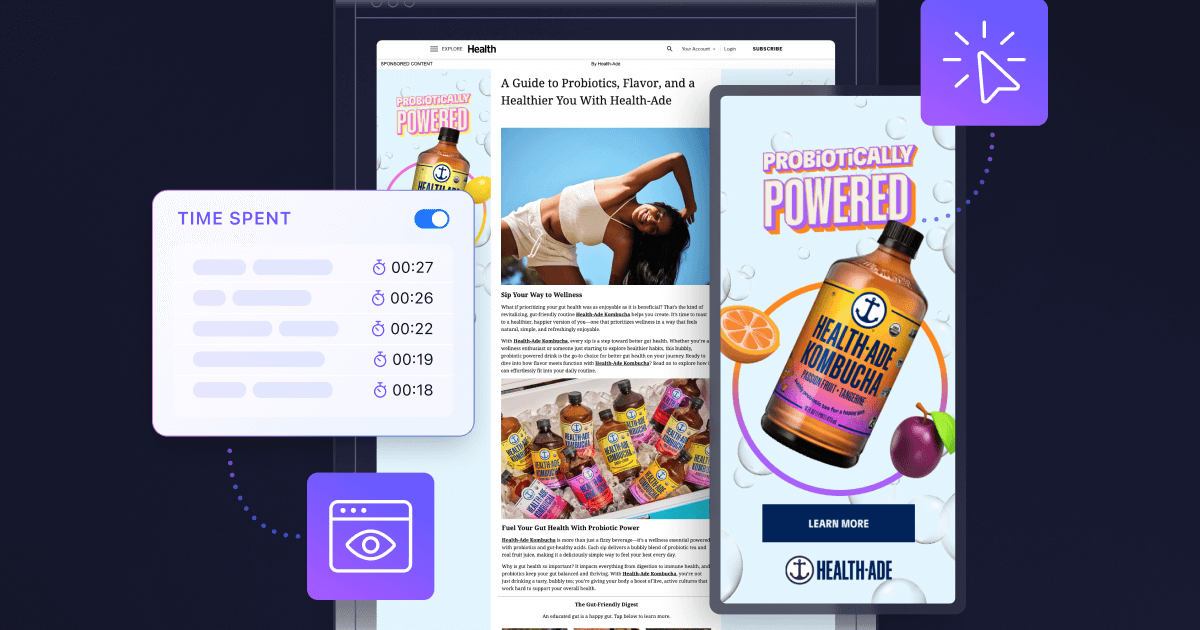What Is the Success Rate of Native Ads?
.png)
In an evolving privacy landscape, and as consumers increasingly demand authenticity and relevance in their interactions with brands, native advertising has proven to be a remarkably successful strategy, achieving higher engagement rates than traditional advertising methods—all without trampling expectations and requirements around privacy.
As we navigate an era where ad-blockers and banner blindness pose challenges to traditional advertising, native advertising stands out by aligning seamlessly with the form and function of the platforms they inhabit. The success of native advertising is underscored by its ability to create a positive user experience, offering valuable information or entertainment in a format that feels organic and welcome.
So, how should advertisers be thinking about native advertising in the context of their broader advertising efforts, and what success rates should they expect? Let’s dig deeper.
Why Attention Matters
When discussing how to measure the success rate of native ads, we need to first talk about attention. Particularly as we move forward into a cookieless ecosystem, attention represents a foundational metric that marketers need to understand and prioritize.
In a digital world where users are inundated with a constant stream of information and advertisements, capturing and maintaining audience attention has become the paramount challenge for advertisers. While metrics like viewability provide quantitative data about an ad's visibility, attention transcends this metric by focusing on the depth of engagement. Attention reflects the genuine interest and cognitive investment of users, signifying a more meaningful connection with the content. An ad that garners attention not only ensures exposure but also lays the groundwork for brand recall, positive associations, and a potential conversion journey.
Common metrics like viewability and clicks fall short in conveying the true impact of an ad. Viewability measures whether an ad is visible on a screen, but it doesn't guarantee that users are actively engaged or absorbing the content. Clicks, on the other hand, can be a misleading metric, as they may be fraudulent, accidental, or not necessarily correlate with genuine interest or conversion intent. Attention, as a metric, delves deeper, encompassing factors such as dwell time, interaction duration, and the emotional resonance an ad elicits. By prioritizing attention, advertisers gain a more nuanced understanding of how their content resonates with the audience, enabling them to refine strategies for maximum impact in an era where fleeting glances are the norm.
How Native Ads Perform Compared to Other Formats
So, when the average consumer sees 6,000 ads a day, how do you break through the clutter to make a connection? This is where marketers should put attention-based metrics to work. Here’s what we know when it comes to the amount of attention generated by various ad formats:
- 0.7 seconds - standard display ads
- 1.7 seconds - Facebook mobile ads
- 3.1 seconds - click-to-play (CTP) video ads
- 13.1 seconds - scroll-to-play (STP) video ads
- 57.4 seconds - Nativo Native Article ads
We know that certain ad formats, like display ads and mobile ads in social networks like Facebook, command less than 2 seconds of attention time, and it takes less than 24 hours before memory decay sets in. On the other hand, other formats—like STP video and especially native article ads—command more than 10 seconds of attention time and persist in a user’s memory for 50+ days.
Importantly, we also know that optimizing campaigns to improve attention, versus another metric like viewability, provides full-funnel value for advertisers. Specifically:
- Familiarity: Campaigns see a +85 percent higher lift from attention-based optimizations.
- Perception: Campaigns see a +77 percent higher lift from attention-based optimizations.
- ROI: Campaigns see a +180 percent higher correlation with attention vs. viewability.
The Importance of Branding via Native Advertising
One reason attention-driving formats like native advertising are so important is because they simultaneously help brands improve both awareness and consideration. Why is increasing awareness and consideration important? Well, research shows that increasing awareness and consideration by just 1 percent also leads to a 1 percent increase in sales, combined with a 1 percent decrease in short-term costs per acquisition. Furthermore, branded content has been shown to drive a 5-point increase in familiarity and a 9-point increase in affinity.
Taken together, all of this data points to one conclusion: Native advertising is one of the most successful advertising tactics in the market when it comes to the most important metric: attention. By elevating a company’s branded content, native advertising drives full-funnel impact and helps brands and agencies break through in an ever-more-cluttered digital media landscape.

.jpg)


